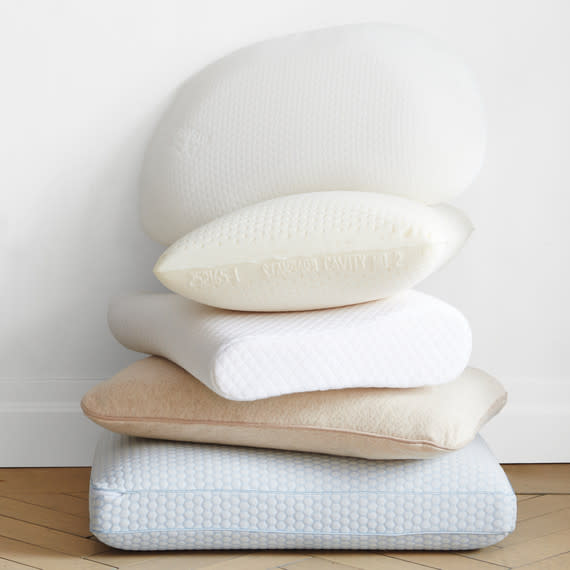Six Signs That It's Time to Replace Your Pillow

Fair warning: You don't want to know what can live in your pillow. But since you're here, we'll tell you. It's a mix of bugs, dead skin, and house dust mites and their feces. Gross. (Pillow cases may be even worse. A study by Amerisleep found that after just one week of not washing a pillow case, it held 17,422 times more bacteria than an average U.S. toilet seat.) With visions of bugs and bacteria dancing in your head, you may be wondering when's the right time to replace your pillow. But even if germs aren't a major concern for you, there are other reasons to question your pillow's lifecycle. Pillows that have lost their form—or take on a new or uncomfortable shape—can negatively impact your quality of sleep. What's more, a change to your own sleep style can mean an old pillow no longer suits your needs.
And while there is no hard-and-fast timeline for when to replace a pillow, there are some signs that show you should make a swap. Here, then, are six signs it's time for a new pillow.
RELATED: Pillow Projects That are Perfectly Cozy and Comfortable
Your pillow smells.
If you smell an odor when you put head down to sleep, then it's time get a new pillow, says Barry Cik, founder and technical director of Naturepedic. "Smell could be a sign that body odor and bacteria have seeped through the surface of the pillow," he explains. (Unpleasant body and bacterial odors shouldn't be confused with the aroma of a new synthetic memory foam pillow though, which "are arguably smelly out of the box" due to chemicals, Cik says.)
You wake up with neck pain or a headache.
If your neck feels strained in the morning or your head is pounding for no apparent reason, your pillow could be to blame, says David Klose, Amerisleep's certified sleep science coach. That could be because your pillow has lost its firmness or bounce—or because you picked the wrong pillow for your sleep style. "Side sleepers should be on a thicker, firmer pillow," advises Klose, "while back and stomach sleepers should try to use thinner, softer pillows."
Your pillow is discolored.
Our sweat, body oils, and—for those of us who don't wash up before bed—makeup, often can permeate our pillowcases and seep into the pillow itself, which causes staining. "It's a sign that it's the right time to change your pillow if you notice color changes," Cik advises.
You feel lumps in your pillow.
A lumpy pillow is a pillow that needs to be replaced. Lumps "can lead to uneven support and increased tossing and turning," Klose says, adding that when there are lumps in your pillow, "only certain parts of your pillow will be comfortable—which makes it harder for your body to reposition itself as needed throughout the night," leading to sleepless nights.
Your sleep position has changed.
If you were once a back sleeper but now you're content to snooze on your side, it's likely time to swap your pillow for one that better fits your sleep style. That's true for "women who are pregnant or folks that have changed sleep positions due to injury," too, says Cik, who explains that "your old pillow might no longer provide the right type of support."
Your pillow fails the "bend test."
Bend your pillow in half and then let go. A pillow that snaps back into its original position is still in good shape. A pillow that doesn't, however, "may have lost its ability to support you as you sleep," says Klose. The same is true for a pillow you often find you must re-fluff or re-position through the night. "A pillow that falls flat or loses its shape while you use it can disrupt an otherwise peaceful slumber," he says.
